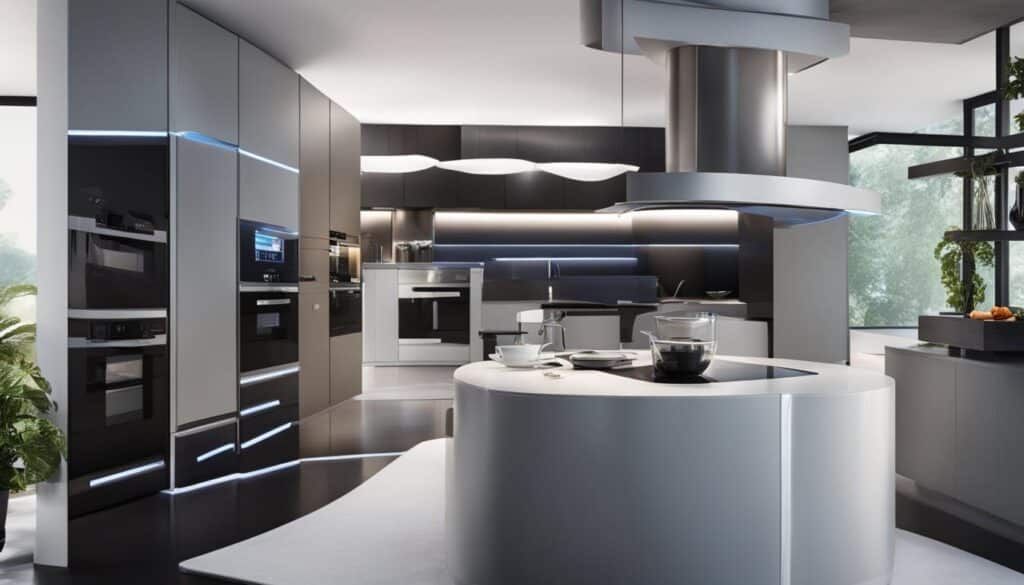Welcome to my article on demystifying Zigbee technology in home automation. In this blog post, I will provide you with a comprehensive understanding of Zigbee, its role in home automation, and its advantages in creating a smart and connected living environment.
Table of Contents
Key Takeaways:
- Zigbee is a wireless communication protocol designed for low-power, low-data-rate applications in home automation.
- Zigbee devices can form a mesh network, enabling reliable and scalable connectivity.
- Zigbee offers advantages such as low-power consumption, mesh networking, and strong security.
- Zigbee devices include sensors, switches, lights, thermostats, and more.
- Implementing Zigbee in your home automation system requires Zigbee-compatible devices and a Zigbee coordinator or hub.
Understanding Zigbee vs. Wi-Fi in Home Automation
When it comes to home automation, two wireless technologies stand out: Zigbee and Wi-Fi. While both provide connectivity, it’s essential to understand their differences to make an informed decision for your smart home setup.
Zigbee:
Zigbee operates on low power, making it ideal for low-data-rate applications like smart home devices. It offers a mesh network topology, enabling devices to communicate with one another and extend the range of the network. Zigbee’s mesh network ensures reliable connectivity and eliminates the need for a centralized hub or single point of failure. It’s commonly used for devices such as sensors, switches, and lights in a smart home setup.
Wi-Fi:
On the other hand, Wi-Fi provides higher data rates and is better suited for applications that require high bandwidth, such as streaming video or gaming. However, Wi-Fi does not offer a mesh network by default, which may require the use of repeaters or range extenders to cover larger areas in your home. Wi-Fi is commonly used for devices that require high bandwidth or internet connectivity, such as voice assistants or streaming devices.
Here’s a quick comparison between Zigbee and Wi-Fi in home automation:
| Zigbee | Wi-Fi |
|---|---|
| Operates on low power | Provides higher data rates |
| Offers mesh network topology | Does not offer a mesh network by default |
| Mainly used for low-data-rate applications | Mainly used for high-bandwidth applications |
As you can see, both Zigbee and Wi-Fi have their strengths and suit different purposes in a smart home. To create a well-rounded and efficient automation system, you can leverage the benefits of both technologies, utilizing Zigbee for low-power devices and Wi-Fi for devices that require high bandwidth or internet connectivity.
Note: It’s also worth mentioning that Zigbee and Wi-Fi operate on separate frequency bands. Zigbee uses the 2.4 GHz frequency band, while Wi-Fi operates on either the 2.4 GHz or 5 GHz band. This distinction helps reduce the chances of interference and congestion in wireless environments.

In conclusion, understanding the differences between Zigbee and Wi-Fi is crucial when setting up a smart home. By utilizing the strengths of each technology, you can create a seamlessly connected and intelligent living environment that caters to your specific needs.
Advantages of Zigbee in Home Automation
Zigbee offers several advantages for home automation systems. Firstly, its low-power consumption allows devices to operate on battery power for extended periods, making it suitable for battery-operated sensors and remote controls. With Zigbee’s efficient power usage, homeowners can enjoy the convenience of wireless control without constantly replacing batteries.
Secondly, the mesh network capability of Zigbee allows for better coverage and reliability. This means that Zigbee devices can communicate with each other and create a self-healing network. Messages are automatically routed through multiple devices, strengthening the connection and eliminating the need for a centralized hub or relying on a single device for communication. This makes Zigbee networks more robust, scalable, and resistant to network failures.
Zigbee’s mesh network is especially beneficial for large homes or properties with multiple floors, as it extends the range of the network and ensures a reliable connection between devices. With Zigbee, homeowners can easily expand their smart home network without worrying about connectivity issues.
Additionally, Zigbee operates on a separate frequency band (2.4 GHz) from Wi-Fi, reducing the chances of interference and congestion in crowded wireless environments. This means that Zigbee devices can coexist with Wi-Fi networks without causing signal degradation or disruptions. Homeowners can enjoy seamless connectivity and performance from both their Zigbee devices and Wi-Fi network.
Furthermore, Zigbee provides strong security measures to protect the communication between devices. This ensures privacy and data integrity in smart home applications. With Zigbee, homeowners can have peace of mind knowing that their connected devices are secure and their personal information is safeguarded.
“Zigbee’s low-power consumption, mesh networking, and strong security make it an ideal technology for home automation.” – Home Automation Magazine
In summary, Zigbee’s advantages in home automation include its low-power consumption, mesh network capability, reduced interference with Wi-Fi, and robust security measures. These features make Zigbee a reliable and efficient choice for creating a smart and connected home environment.
Zigbee Devices in Home Automation
Zigbee devices are essential components of any efficient home automation system. These devices, including sensors, switches, lights, thermostats, and door locks, enable seamless control and automation of various aspects within a smart home environment.
By leveraging the Zigbee communication protocol, these devices establish a network that facilitates smooth and reliable communication between them. This network enables homeowners to effortlessly manage and monitor their smart home devices.
For instance, Zigbee sensors can detect motion, temperature, humidity, and occupancy, triggering actions such as turning on lights or adjusting the thermostat based on predefined rules. Zigbee switches allow for convenient wireless control of lights, fans, and other electrical appliances.
Zigbee devices also offer the convenience of integration with other smart home ecosystems. They can be seamlessly integrated with popular voice assistants or mobile apps, providing centralized control and monitoring of the entire smart home network. This integration enables homeowners to control their Zigbee devices using voice commands or through user-friendly mobile applications.
Benefits of Zigbee Devices in Home Automation:
- Seamless control and automation of smart home devices
- Detection of motion, temperature, humidity, and occupancy for triggering actions
- Wireless control of lights, fans, and other electrical appliances
- Easier integration with voice assistants and mobile apps for centralized control
In summary, Zigbee devices are instrumental in creating a connected and intelligent living environment. Their ability to communicate and form a network using the Zigbee communication protocol enables homeowners to enjoy the benefits of home automation in a hassle-free and intuitive manner.

The Future of Zigbee in Home Automation
Zigbee has a promising future in the field of home automation. As more homes embrace smart technologies, the demand for reliable and interoperable wireless communication protocols like Zigbee is steadily increasing. The unique combination of Zigbee’s low-power consumption, mesh network capability, and robust security features positions it as an ideal choice for home automation applications.
The low-power consumption of Zigbee devices allows them to operate on battery power for extended periods, making them suitable for battery-operated sensors and remote controls. This energy-efficient approach ensures continuous functionality without the need for frequent battery replacements or recharging.
Add to that, Zigbee’s mesh network capability enables devices to communicate with each other, forming a flexible and scalable network. This mesh network architecture eliminates the reliance on a single point of failure and expands the range of the network, providing better coverage throughout the smart home.
Furthermore, Zigbee’s strong security features add an extra layer of protection to ensure privacy and data integrity in smart home applications. This is essential in an era where data breaches and privacy concerns are growing.
With the increasing popularity of voice assistants and mobile apps, easy integration of Zigbee devices into existing smart home ecosystems becomes possible. This seamless integration allows for centralized control and monitoring of the entire smart home network, enhancing the overall user experience.
The Zigbee Alliance, an organization dedicated to promoting and developing Zigbee technology, continues to innovate and expand its capabilities to cater to the evolving needs of the smart home market. This commitment ensures that Zigbee will remain at the forefront of home automation, driving technological advancements and empowering users with more intelligent and interconnected living environments.
| Advantages of Zigbee in Home Automation | The Future of Zigbee in Home Automation |
|---|---|
| – Low power consumption | – Increasing demand for reliable wireless protocols |
| – Mesh network capability | – Zigbee’s unique features |
| – Strong security measures | – Seamless integration with voice assistants and mobile apps |
| – Ongoing innovation by the Zigbee Alliance |
Implementing Zigbee in Your Home Automation System
To implement Zigbee in your home automation system, you will need Zigbee-compatible devices and a Zigbee coordinator or hub. Zigbee devices are available from various manufacturers and come in different forms, such as sensors, switches, lights, and thermostats. These devices should be labeled as Zigbee-compatible or Zigbee-certified to ensure interoperability.
The Zigbee coordinator or hub acts as the central control point for the Zigbee network, allowing you to connect and control all Zigbee devices in your smart home. Some popular Zigbee hubs include:
- Philips Hue Bridge
- SmartThings Hub
- Amazon Echo Plus
Once you have the devices and hub, you can follow the manufacturer’s instructions to set up and configure your Zigbee network. This typically involves:
- Connecting the hub to your home network.
- Adding Zigbee devices to the network.
- Configuring automation rules and schedules through the hub’s interface or a companion app.
With Zigbee technology, you can create a seamlessly connected and intelligent home automation system.
| Aspect | Zigbee | Wi-Fi |
|---|---|---|
| Range | Short to medium | Long |
| Power Consumption | Low | High |
| Interference | Minimal | Potential for congestion in crowded areas |
| Network Topology | Mesh network | Point-to-point |
| Applications | Low-data-rate devices, sensors, switches | High-bandwidth devices, streaming, gaming |
Conclusion
Zigbee technology revolutionizes home automation by delivering low-power, secure, and scalable solutions for creating intelligent living environments. With its unique advantages, Zigbee has become the go-to wireless communication protocol for smart homes.
By implementing Zigbee in your home automation system, you can enjoy a seamless and interconnected network of devices. Zigbee enables efficient communication between sensors, switches, lights, and other devices, allowing you to exercise complete control over various aspects of your smart home.
As the demand for smart homes continues to soar, Zigbee is poised to play an increasingly vital role in the future of home automation. Its robust mesh network, low power consumption, and strong security measures make it an ideal choice for creating a connected and intelligent living environment.
Experience the benefits of Zigbee technology in your home automation system and unlock a new level of convenience, energy efficiency, and comfort. With Zigbee, you can transform your house into a smart home and embrace the future of home automation.
FAQ
What is Zigbee technology and its role in home automation?
Zigbee is a wireless communication protocol specifically designed for low-power, low-data-rate applications in home automation and other industrial sectors. It enables devices to form a mesh network, providing reliable and scalable connectivity in a smart home.
How does Zigbee differ from Wi-Fi in home automation?
Zigbee operates on low power and is suitable for low-data-rate applications, while Wi-Fi provides higher data rates and is better for high-bandwidth applications. Zigbee offers a mesh network topology, which extends the range of the network, while Wi-Fi does not.
What are the advantages of using Zigbee in home automation?
Zigbee has low-power consumption, a mesh network capability for better coverage, and strong security measures. It operates on a separate frequency band from Wi-Fi, reducing interference, and offers scalability for a growing smart home network.
What kind of devices can be used in Zigbee home automation systems?
Zigbee devices include sensors, switches, lights, thermostats, door locks, and more. They communicate with each other using the Zigbee communication protocol, allowing seamless control and automation of various aspects of a smart home.
What is the future of Zigbee in home automation?
With the increasing demand for smart homes, Zigbee is expected to play a significant role in the future. Its low-power consumption, mesh network capability, and strong security features make it an ideal choice for home automation applications.
How can I implement Zigbee in my home automation system?
To implement Zigbee, you will need Zigbee-compatible devices and a Zigbee coordinator or hub. These devices should be labeled as Zigbee-compatible, and the hub acts as the central control point for the Zigbee network. You can follow the manufacturer’s instructions to set up and configure your Zigbee network.
What is the conclusion about Zigbee technology in home automation?
Zigbee technology plays a significant role in home automation, offering advantages such as low-power consumption, mesh networking, and strong security. By implementing Zigbee in your home automation system, you can enjoy the benefits of a connected and intelligent living environment.


